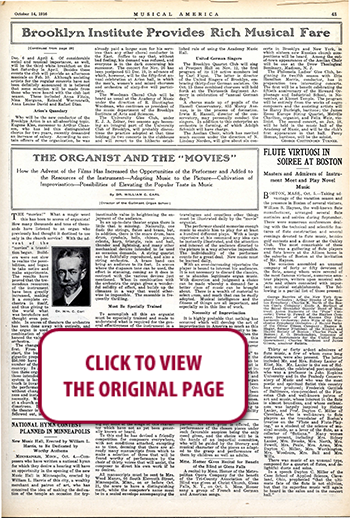 100 YEARS AGO IN MUSICAL AMERICA (164)
100 YEARS AGO IN MUSICAL AMERICA (164)
October 14, 1916
Page 43
THE ORGANIST AND THE "MOVIES”
How the Advent of the Films Has Increased the Opportunities of the Performer and Added to the Resources of the Instrument—Adapting Music to the Picture—Cultivation of Improvisation—Possibilities of Elevating the Popular Taste in Music
By DR. WILLIAM C. CARL [Director of the Guilmant Organ School]
THE “movies!” What a magic word this has been to scores of organists! How many thousands and tens of thousands have listened to an organ who previously had thought it destined to use only in the church service! With the advent of the “movies” a transition began. Builders were not slow to realize the possibilities, and began to take notice and make experiments. The results have proved that the tremendous resources of the instrument have been greatly increased, making it a complete orchestra in itself, and thus giving to the world what was heretofore not thought even possible. In scores of theaters the orchestra has been done away with entirely and the organ is used solely. In others a combination of the two has greatly enhanced the value and effectiveness of the orchestra.
The change came in a small way at first. From small instruments at the start, the business has grown to such gigantic proportions that organs costing $50,000 have been installed in a large number of theaters scattered through the country. In general plan and construction these organs are quite different from those intended for church use. The unit system is largely used, and the double touch is invariably found. This enables the performer to bring out the themes without change of register, for promptness and instant changes are an absolute necessity. Were the same effects used as at a church service, the results would be disastrous. Instead, a style adapted to the theater is required, and, if properly followed out, is an adjunct which is of inestimable value in heightening the enjoyment of the audience.
In an up-to-date theater organ there is little that is missing. Naturally, one finds the strings, flutes and brass, but, in addition, there is the snare drum, bass drum, cymbals, bells, chimes, piano, celesta, harp, triangle, rain and hail, thunder and lightning, and many other mechanical devices intended to be used as occasion demands. A string quartet can be faithfully reproduced, and also a string orchestra. A brass band can bring an audience to its feet. In scenes where the diapason tone can be used, the effect is stunning, coming as it does in contrast with the various devices just mentioned. When in combination with the orchestra the organ gives a wonderful solidity of effect, and builds up the climaxes in a way that would otherwise be impossible. The ensemble is frequently thrilling.
Must Be Specially Trained
To accomplish all this an organist must be especially trained and made to understand what is required for the general effectiveness of the instrument in a theater and its environment. Atmosphere must be created that will transfer the audience to the scene of the picture and make it forget all else. This can be done and has been accomplished by many of our best players. The great point is to “play” the picture; not to give an organ recital while the picture is being shown, but instead, to illustrate on the organ what is being shown on the screen. For instance, in a great procession the music must move with the actors. All emotions must be reproduced, and the performer should be on the alert so that not a single point or incident escapes his attention. One picture which can be recalled introduced several great artists on the screen—Verdi, Wagner, Mendelssohn, Beethoven, Bach and Handel. As each appeared a few measures from his works were played, adding materially to the value of the picture. Pastoral scenes, storms, comedies, tragedies, melodramas, travelogues and countless other things must be illustrated daily by the “movie” organist.
The performer should memorize enough music to enable him to play for at least a hundred different plays. With a large repertoire at his command any idea can be instantly illustrated, and the attention and interest of the audience directed to the picture in a way otherwise impossible. The individuality of the performer counts for a great deal. New music must be learned daily.
With an ever-increasing répertoire the player is bound to interest his audiences. It is not necessary to discard the classics, or to abandon legitimate organ music. With discretion and judgment a choice can be made whereby a demand for a better class of music can be brought about. There is a wealth of material to select from, and much that can be easily adopted. Musical intelligence and the fitness of things are all important, and especially so in this line of work.
Necessity of Improvisation
It is highly probable that nothing has occurred which will develop the art of improvisation in America so much as this work. It is an absolute necessity to improvise. If this cannot be done, then the performance suffers. Therefore, this much-neglected art is destined to come into its own and be developed as never before.
People do not attend the “movies” to hear an organ recital. They want the picture reproduced in tone. This can be done with a judicious choice of what is not severely classical in character, but including at the same time selections which will eventually raise the standard and create a desire for the best. The organ in the theater is a success, and has been so since the advent of the “movies.” Organists who otherwise would have been unknown have made enviable reputations and greatly increased their incomes. “Success,” I say, to the man who takes up this line of work and is willing to develop it, keeping in mind the possibility of attaining the highest ideals.




 RENT A PHOTO
RENT A PHOTO





